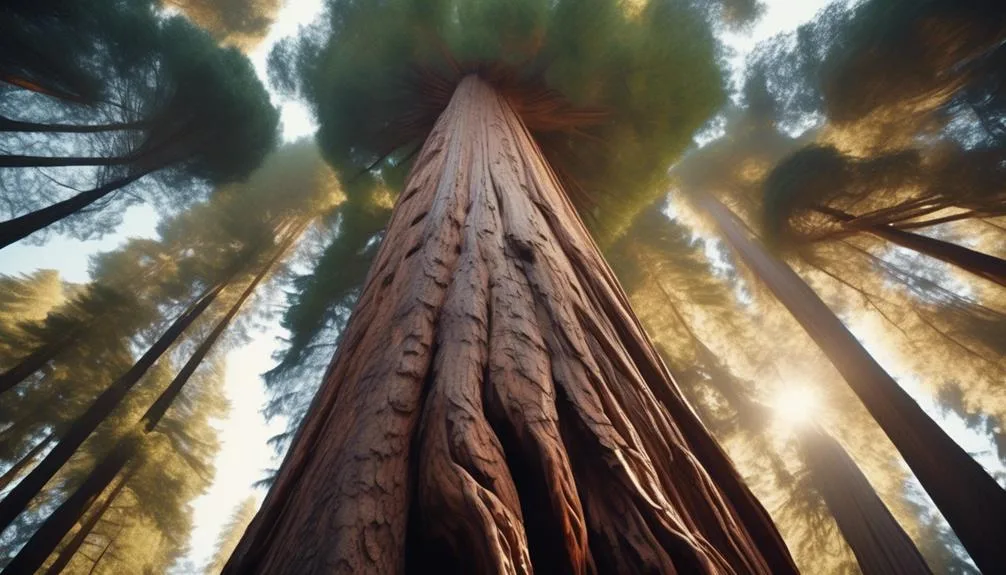Ever wondered why redwood trees have such thick trunks? These towering giants can grow over 350 feet tall with trunks exceeding 20 feet in diameter.
But the reason behind their impressive girth is more than just for show. There are fascinating explanations behind this natural wonder.
Genetics
Understanding the genetics behind the thick trunks of redwood trees reveals the fascinating mechanisms that contribute to their impressive growth. Redwoods have unique inheritance patterns that result in their massive trunks. The inheritance patterns of redwood trees involve the passing down of specific genetic traits from one generation to the next, leading to the development of thick trunks.
Genetic mutations play a significant role in this process. These mutations occur spontaneously and can also contribute to the robust growth of redwoods. They can lead to the development of traits that enhance the tree's ability to thrive and grow, ultimately contributing to the formation of their iconic thick trunks.
Environmental Adaptation
Adapting to their surroundings, redwood trees employ various strategies to thrive in diverse environmental conditions, contributing to their remarkable resilience and longevity.
- Efficient Water Uptake: Redwoods have evolved to efficiently extract water from the soil through their shallow root systems, allowing them to thrive in moisture-laden environments such as foggy coastal regions.
- Fire Resistance: Redwood trees have developed thick, fire-resistant bark that provides an evolutionary advantage in regions prone to wildfires, allowing them to survive and even thrive in fire-prone areas.
- Climate Resilience: Redwoods exhibit remarkable climate resilience, with their ability to withstand harsh winds and storms, making them well-suited for a variety of environmental conditions.
These environmental adaptations not only ensure the survival of redwood trees but also contribute to their ecological significance and longevity in diverse habitats.
Water Absorption
Thriving in diverse environments due to their efficient water uptake and resilience to climate extremes, redwood trees exemplify remarkable adaptability to varying moisture levels and environmental conditions. Redwoods have evolved to excel in water absorption, with their roots extending wide and deep to capture water from the fog-laden air and the damp forest floor.
The tree rings of redwoods not only reveal their age but also serve as a historical record of their water intake, reflecting periods of drought and abundance. Their incredible ability to absorb and store water contributes to their impressive carbon sequestration, as they use the captured carbon to build their massive trunks.
This process helps mitigate climate change by removing carbon dioxide from the atmosphere and locking it away for centuries within their sturdy, resilient frames.
Structural Support
Redwood trees develop thick trunks to provide the necessary structural support for their towering height and immense weight, ensuring stability and longevity in their demanding environment. This structural support is achieved through a combination of factors:
- Mechanical Strength: Redwood trees possess a remarkable ability to develop dense wood with high mechanical strength. The wood is composed of strong fibers that provide support against gravitational forces and the stress of strong winds.
- Tree Anatomy: The internal anatomy of redwood trees is specifically adapted to provide structural support. The presence of thick bark and a wide trunk helps distribute the weight of the tree evenly, preventing it from toppling over despite its enormous size.
- Root System: The extensive root system of redwood trees also plays a crucial role in providing structural support by anchoring the tree securely into the ground, further enhancing its stability.
Longevity
To achieve remarkable longevity, redwood trees develop a dense, resilient wood that resists decay and contributes to their enduring presence in their environment. The growth rings in their trunks not only reveal the tree's age but also provide insight into past environmental conditions. By analyzing these rings using carbon dating, scientists can uncover the history of climate change and the impact of human activities such as deforestation on these ancient giants.
Redwoods have adapted to survive for centuries, but they now face new challenges. Climate change and deforestation threaten their continued existence. Despite these challenges, the redwoods' longevity serves as a testament to their resilience and the need for conservation efforts to ensure that these magnificent trees continue to thrive for generations to come.
Conclusion
In marveling at the impressive thickness of redwood tree trunks, we witness nature's ingenious design, blending genetics, adaptation, and resilience.
These towering giants stand as a testament to the harmonious balance between form and function, a timeless symbol of strength and endurance.
As we contemplate their grandeur, we're reminded of the profound beauty and fortitude that grace our natural world.
Mark Hoffman is a dedicated arborist and tree care specialist with over a decade of experience. His love for trees began when he visited Yosemite National Park as a teenager and was awestruck by the giant sequoias. Mark pursued his passion by studying forestry at Michigan Technological University, where he earned a Bachelor of Science degree.
Since then, he has worked tirelessly in the field of arboriculture, helping to preserve and protect trees in his community. His expertise and dedication have made him a respected leader in the industry and a valuable resource for anyone seeking advice on tree care.
